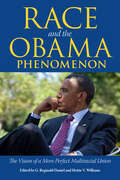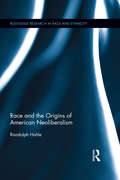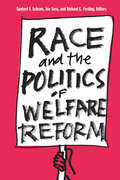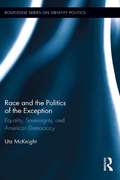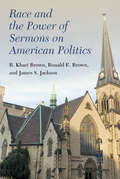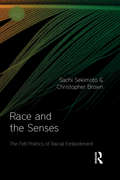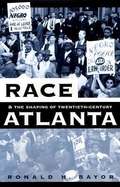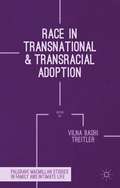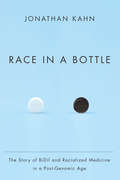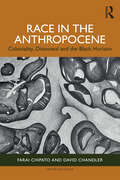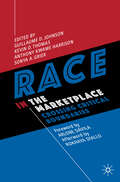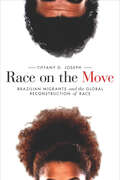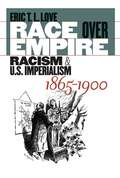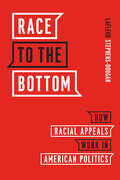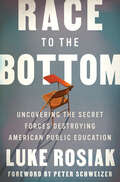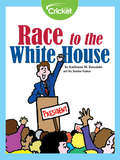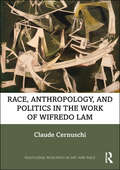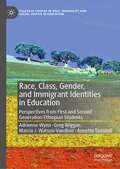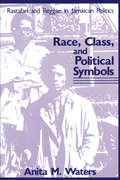- Table View
- List View
Race and the Obama Phenomenon: The Vision of a More Perfect Multiracial Union
by G. Reginald Daniel and Hettie V. WilliamsThe concept of a more perfect union remains a constant theme in the political rhetoric of Barack Obama. From his now historic race speech to his second victory speech delivered on November 7, 2012, that striving is evident. “Tonight, more than two hundred years after a former colony won the right to determine its own destiny, the task of perfecting our union moves forward,” stated the forty-fourth president of the United States upon securing a second term in office after a hard-fought political contest. Obama borrows this rhetoric from the founding documents of the United States set forth in the US Constitution and in Abraham Lincoln's “Gettysburg Address.” How naive or realistic is Obama's vision of a more perfect American union that brings together people across racial, class, and political lines? How can this vision of a more inclusive America be realized in a society that remains racist at its core? These essays seek answers to these complicated questions by examining the 2008 and 2012 elections as well as the events of President Obama's first term. Written by preeminent race scholars from multiple disciplines, the volume brings together competing perspectives on race, gender, and the historic significance of Obama's election and reelection. The president heralded in his November 2012, acceptance speech, “The idea that if you're willing to work hard, it doesn't matter who you are, or where you come from, or what you look like . . . . whether you're black or white, Hispanic or Asian or Native American.” These essayists argue the truth of that statement and assess whether America has made any progress toward that vision.
Race and the Origins of American Neoliberalism (Routledge Research in Race and Ethnicity #12)
by Randolph HohleWhy did the United States forsake its support for public works projects, public schools, public spaces, and high corporate taxes for the neoliberal project that uses the state to benefit businesses at the expense of citizens? The short answer to this question is race. This book argues that the white response to the black civil rights movement in the 1950s, '60s, and early '70s inadvertently created the conditions for emergence of American neoliberalism. Neoliberalism is the result of an unlikely alliance of an elite liberal business class and local segregationists that sought to preserve white privilege in the civil rights era. The white response drew from a language of neoliberalism, as they turned inward to redefine what it meant to be a good white citizen. The language of neoliberalism depoliticized class tensions by getting whites to identify as white first, and as part of a social class second. This book explores the four pillars of neoliberal policy, austerity, privatization, deregulation, and tax cuts, and explains how race created the pretext for the activation of neoliberal policy. Neoliberalism is not about free markets. It is about controlling the state to protect elite white economic privileges.
Race and the Politics of Welfare Reform
by Sanford Schram Joe Soss Richard C. FordingIt's hard to imagine discussing welfare policy without discussing race, yet all too often this uncomfortable factor is avoided or simply ignored. Sometimes the relationship between welfare and race is treated as so self-evident as to need no further attention; equally often, race in the context of welfare is glossed over, lest it raise hard questions about racism in American society as a whole. Either way, ducking the issue misrepresents the facts and misleads the public and policy-makers alike. Many scholars have addressed specific aspects of this subject, but until now there has been no single integrated overview. Race and the Politics of Welfare Reform is designed to fill this need and provide a forum for a range of voices and perspectives that reaffirm the key role race has played--and continues to play--in our approach to poverty. The essays collected here offer a systematic, step-by-step approach to the issue. Part 1 traces the evolution of welfare from the 1930s to the sweeping Clinton-era reforms, providing a historical context within which to consider today's attitudes and strategies. Part 2 looks at media representation and public perception, observing, for instance, that although blacks accounted for only about one-third of America's poor from 1967 to 1992, they featured in nearly two-thirds of news stories on poverty, a bias inevitably reflected in public attitudes. Part 3 discusses public discourse, asking questions like "Whose voices get heard and why?" and "What does 'race' mean to different constituencies?" For although "old-fashioned" racism has been replaced by euphemism, many of the same underlying prejudices still drive welfare debates--and indeed are all the more pernicious for being unspoken. Part 4 examines policy choices and implementation, showing how even the best-intentioned reform often simply displaces institutional inequities to the individual level--bias exercised case by case but no less discriminatory in effect. Part 5 explores the effects of welfare reform and the implications of transferring policy-making to the states, where local politics and increasing use of referendum balloting introduce new, often unpredictable concerns. Finally, Frances Fox Piven's concluding commentary, "Why Welfare Is Racist," offers a provocative response to the views expressed in the pages that have gone before--intended not as a "last word" but rather as the opening argument in an ongoing, necessary, and newly envisioned national debate.
Race and the Politics of the Exception: Equality, Sovereignty, and American Democracy (Routledge Series on Identity Politics)
by Utz McKnightThe traditional assumption today about race is that it is not political; that it has no political content and is a matter of individual beliefs and attitudes. In Race and the Politics of the Exception, Utz McKnight argues that race is in fact political and defines how it functions as a politics in the United States. McKnight organizes his book into three sections, beginning with a theoretical section about racial politics in the United States. Using theorists such as Benjamin, Agamben, and Schmitt, McKnight discusses how the idea of racial communities went from being constituted through the idea of racial sovereignty and a politics of the exception that defined blacks as the internal enemy, to being constitutionally defined through the institutions of racial equal opportunity. In the second section, McKnight further develops his critical race theory by exploring in more detail the social use of race today. The election of President Obama has brought the politics of racial equality to a critical point. In spite of a very powerful set of political tools to define it as a thing of the past, race matters. In the final section, McKnight engages with important African American fiction from each of the three major periods of racial politics in the US. Earlier descriptions of political theory are used throughout these analyses to refine the argument for a new critical politics of race. Scholars of political theory, identity politics, African American studies, and American Studies will find this work ground-breaking and relevant.
Race and the Power of Sermons on American Politics
by James Jackson R. Khari Brown Ronald E BrownThis book examines the intersection of race, political sermons, and social justice. Religious leaders and congregants who discuss and encourage others to do social justice embrace a form of civil religion that falls close to the covenantal wing of American civil religious thought. Clergy and members who share this theological outlook frame the nation as being exceptional in God’s sight. They also emphasize that the nation’s special relationship with the Creator is contingent on the nation working toward providing opportunities for socioeconomic well-being, freedom, and creative pursuits. God’s covenant, thus, requires inclusion of people who may have different life experiences but who, nonetheless, are equally valued by God and worthy of dignity. Adherents to such a civil religious worldview would believe it right to care for and be in solidarity with the poor and powerless, even if they are undocumented immigrants, people living in non-democratic and non-capitalist nations, or members of racial or cultural out-groups. Relying on 44 national and regional surveys conducted between 1941 and 2019, Race and the Power of Sermons on American Politics explores how racial experiences impact the degree to which religion informs social justice attitudes and political behavior. This is the most comprehensive set of analyses of publicly available survey data on this topic.
Race and the Senses: The Felt Politics of Racial Embodiment (Sensory Studies)
by Christopher Brown Sachi SekimotoIn Race and the Senses, Sachi Sekimoto and Christopher Brown explore the sensorial and phenomenological materiality of race as it is felt and sensed by the racialized subjects. Situating the lived body as an active, affective, and sensing participant in racialized realities, they argue that race is not simply marked on our bodies, but rather felt and registered through our senses. They illuminate the sensorial landscape of racialized world by combining the scholarship in sensory studies, phenomenology, and intercultural communication. Each chapter elaborates on the felt bodily sensations of race, racism, and racialization that illuminate how somatic labor plays a significant role in the construction of racialized relations of sensing. Their thought-provoking theorizing about the relationship between race and the senses include race as a sensory assemblage, the phenomenology of the racialized face and tongue, kinesthetic feelings of blackness, as well as the possibility of cross-racial empathy. Race is not merely socially constructed, but multisensorially assembled, engaged, and experienced. Grounded in the authors’ experiences, one as a Japanese woman living in the USA, and the other as an African American man from Chicago, Race and the Senses is a book about how we feel the racialized world into being.
Race and the Shaping of Twentieth-Century Atlanta
by Ronald H. BayorAtlanta is often cited as a prime example of a progressive New South metropolis in which blacks and whites have forged "a city too busy to hate." But Ronald Bayor argues that the city continues to bear the indelible mark of racial bias. Offering the first comprehensive history of Atlanta race relations, he discusses the impact of race on the physical and institutional development of the city from the end of the Civil War through the mayorship of Andrew Young in the 1980s. Bayor shows the extent of inequality, investigates the gap between rhetoric and reality, and presents a fresh analysis of the legacy of segregation and race relations for the American urban environment. Bayor explores frequently ignored public policy issues through the lens of race--including hospital care, highway placement and development, police and fire services, schools, and park use, as well as housing patterns and employment. He finds that racial concerns profoundly shaped Atlanta, as they did other American cities. Drawing on oral interviews and written records, Bayor traces how Atlanta's black leaders and their community have responded to the impact of race on local urban development. By bringing long-term urban development into a discussion of race, Bayor provides an element missing in usual analyses of cities and race relations.
Race and the Totalitarian Century
by Vaughn RasberryVaughn Rasberry turns to black culture and politics for an alternative history of the totalitarian century. He shows how black writers reimagined the standard anti-fascist, anti-communist narrative through the lens of racial injustice, with the U.S. as a tyrannical force in the Third World but also an agent of Asian and African independence.
Race for the Reichstag: The 1945 Battle for Berlin (Soviet (Russian) Military Experience #No. 4)
by Tony, Le Tissier MBEThe soldiers of the Red Army identified the Reichstag as the victor's prize to be taken in Berlin. This account of the battle lays the many myths created by Soviet propaganda after the event to rest and details what exactly happened as the Red Army and the Allies raced to be the first at the Reichstag.
Race in Transnational and Transracial Adoption
by Vilna Bashi TreitlerWhen parents form families by reaching across social barriers (the color line, or the boundaries between 'First World' and 'Third World' nations) to adopt children, where and how does race enter the adoption process? How do agencies, parents, and the adopted children themselves deal with issues of difference in adoption? This volume engages writers from both sides of the Atlantic to take a close look at race in transnational and transracial adoption. The contributors tackle questions of how adoption agencies engage race online; how parents understand race as a factor in raising their adopted children; how culture camps engage with parents and children about racial issues; and how social policy shapes the racial aspects of adoption, for better or worse.
Race in a Bottle: The Story of BiDil and Racialized Medicine in a Post-Genomic Age
by Jonathan KahnAt a ceremony announcing the completion of the first draft of the human genome in 2000, President Bill Clinton declared, "I believe one of the great truths to emerge from this triumphant expedition inside the human genome is that in genetic terms, all human beings, regardless of race, are more than 99.9 percent the same." Yet despite this declaration of unity, biomedical research has focused increasingly on mapping that.1 percent of difference, particularly as it relates to race.This trend is exemplified by the drug BiDil. Approved by the FDA in 2005 as the first drug with a race-specific indication on its label, BiDil was originally touted as a pathbreaking therapy to treat heart failure in black patients and help underserved populations. Upon closer examination, however, Jonathan Kahn reveals a far more complex story. At the most basic level, BiDil became racial through legal maneuvering and commercial pressure as much as through medical understandings of how the drug worked. Using BiDil as a central case study, Kahn broadly examines the legal and commercial imperatives driving the expanding role of race in biomedicine, even as scientific advances in genomics could render the issue irrelevant. He surveys the distinct politics informing the use of race in medicine and the very real health disparities caused by racism and social injustice that are now being cast as a mere function of genetic difference. Calling for a more reasoned approach to using race in biomedical research and practice, Kahn asks readers to recognize that, just as genetics is a complex field requiring sensitivity and expertise, so too is race, particularly in the field of biomedicine.
Race in the Anthropocene: Coloniality, Disavowal and the Black Horizon (ISSN)
by David Chandler Farai ChipatoRace in the Anthropocene provides a radical new perspective on the importance of race and coloniality in the Anthropocene. It forwards the Black Horizon as a critical lens which places at its heart the importance of ontological concerns fundamental to problematising the violences and exclusions of the antiblack world.At present, multiple new approaches are emerging through the shared problem field of Anthropocene thought and policy, offering to save not just the world, but the practice of governance, the business of Big Data, the progress of development, and the dream of peace. It is against this backdrop that Race in the Anthropocene unsettles not just the already shaky foundations of modernity but also the affirmative visions of its critics, by directing our gaze to how race and coloniality are baked into the grounding concepts of international thought.This book is essential reading for students of International Relations, particularly those interested in international politics, security, and development. It is also of relevance for those interested in contemporary social, political, and environmental debates and policy practices.
Race in the Marketplace: Crossing Critical Boundaries
by Guillaume D. Johnson Kevin D. Thomas Anthony Kwame Harrison Sonya A. GrierThis volume offers a critical, cross-disciplinary, and international overview of emerging scholarship addressing the dynamic relationship between race and markets. Chapters are engaging and accessible, with timely and thought-provoking insights that different audiences can engage with and learn from. Each chapter provides a unique journey into a specific marketplace setting and its sociopolitical particularities including, among others, corner stores in the United States, whitening cream in Nigeria and India, video blogs in Great Britain, and hospitals in France. By providing a cohesive collection of cutting-edge work, Race in the Marketplace contributes to the creation of a robust stream of research that directly informs critical scholarship, business practices, activism, and public policy in promoting racial equity.
Race on the Brain: What Implicit Bias Gets Wrong About the Struggle for Racial Justice
by Jonathan KahnOf the many obstacles to racial justice in America, none has received more recent attention than the one that lurks in our subconscious. As social movements and policing scandals have shown how far from being “postracial” we are, the concept of implicit bias has taken center stage in the national conversation about race. Millions of Americans have taken online tests purporting to show the deep, invisible roots of their own prejudice. A recent Oxford study that claims to have found a drug that reduces implicit bias is only the starkest example of a pervasive trend. But what do we risk when we seek the simplicity of a technological diagnosis—and solution—for racism? What do we miss when we locate racism in our biology and our brains rather than in our history and our social practices?In Race on the Brain, Jonathan Kahn argues that implicit bias has grown into a master narrative of race relations—one with profound, if unintended, negative consequences for law, science, and society. He emphasizes its limitations, arguing that while useful as a tool to understand particular types of behavior, it is only one among several tools available to policy makers. An uncritical embrace of implicit bias, to the exclusion of power relations and structural racism, undermines wider civic responsibility for addressing the problem by turning it over to experts. Technological interventions, including many tests for implicit bias, are premised on a color-blind ideal and run the risk of erasing history, denying present reality, and obscuring accountability. Kahn recognizes the significance of implicit social cognition but cautions against seeing it as a panacea for addressing America’s longstanding racial problems. A bracing corrective to what has become a common-sense understanding of the power of prejudice, Race on the Brain challenges us all to engage more thoughtfully and more democratically in the difficult task of promoting racial justice.
Race on the Move: Brazilian Migrants and the Global Reconstruction of Race
by Tiffany D. JosephRace on the Move takes readers on a journey from Brazil to the United States and back again to consider how migration between the two countries is changing Brazilians' understanding of race relations. Brazil once earned a global reputation as a racial paradise, and the United States is infamous for its overt social exclusion of nonwhites. Yet, given the growing Latino and multiracial populations in the United States, the use of quotas to address racial inequality in Brazil, and the flows of people between each country, contemporary race relations in each place are starting to resemble each other. Tiffany Joseph interviewed residents of Governador Valadares, Brazil's largest immigrant-sending city to the U. S. , to ask how their immigrant experiences have transformed local racial understandings. Joseph identifies and examines a phenomenon-the transnational racial optic-through which migrants develop and ascribe social meaning to race in one country, incorporating conceptions of race from another. Analyzing the bi-directional exchange of racial ideals through the experiences of migrants, Race on the Move offers an innovative framework for understanding how race can be remade in immigrant-sending communities.
Race over Empire
by Eric T. LoveGenerations of historians have maintained that in the last decade of the nineteenth century white-supremacist racial ideologies such as Anglo-Saxonism, social Darwinism, benevolent assimilation, and the concept of the "white man's burden" drove American imperialist ventures in the nonwhite world. In Race over Empire, Eric T. L. Love contests this view and argues that racism had nearly the opposite effect. From President Grant's attempt to acquire the Dominican Republic in 1870 to the annexations of Hawaii and the Philippines in 1898, Love demonstrates that the imperialists' relationship with the racist ideologies of the era was antagonistic, not harmonious. In a period marked by Jim Crow, lynching, Chinese exclusion, and immigration restriction, Love argues, no pragmatic politician wanted to place nonwhites at the center of an already controversial project by invoking the concept of the "white man's burden." Furthermore, convictions that defined "whiteness" raised great obstacles to imperialist ambitions, particularly when expansionists entered the tropical zone. In lands thought to be too hot for "white blood," white Americans could never be the main beneficiaries of empire.What emerges from Love's analysis is a critical reinterpretation of the complex interactions between politics, race, labor, immigration, and foreign relations at the dawn of the American century.
Race the Wind (Willow King #2)
by Chris PlattThanks to the faith and hard work of Katie Durham, Willow King no longer has badly twisted legs. After painstaking training, the colt has gained the strength to compete in major races--and Katie is determined to prove he's a champion. Unfortunately, her new ambition presents her with the most nerve-racking challenge of her life: earning a jockey's license and riding Willow King in the Kentucky Derby. This inspiring story, a sequel to the author's award-winning first novel, is based on her real experiences as a jockey, groom, and assistant horse trainer.
Race to Kill
by Rachel Kall"Rachel Kall writes gritty, fast-paced, realistic romantic suspense that carries a punch to the gut and a twist to the heart. Don't miss a word!" --Roxanne St. Claire, New York Times bestselling authorA Love and Scandal Novel (#1)When fiercely independent Vivian Reese is thrust onto the national stage during a heated presidential campaign, she doesn't expect to become a media darling. She also doesn't expect to start to fall for her sexy new bodyguard, Marcus Locke. But when threats start surfacing against the sitting President's campaign and all evidence points to Vivian, she doesn't know who to trust.Delta Force Operator turned FBI agent Marcus Locke is supposed to be investigating campaign finance crimes. He's not supposed to be checking out the sexy, eloquent campaign spokeswoman Vivian Reese, who's one of his prime suspects! But when they are caught in the middle of a presidential race that is quickly turning deadly, he is forced to put both his heart and his job in the line of fire.Tempers flare and passions ignite as the campaign gets dangerous, but when bullets start to fly will either of them survive?
Race to the Bottom: How Racial Appeals Work in American Politics (Chicago Studies in American Politics)
by LaFleur Stephens-DouganAfrican American voters are a key demographic to the modern Democratic base, and conventional wisdom has it that there is political cost to racialized “dog whistles,” especially for Democratic candidates. However, politicians from both parties and from all racial backgrounds continually appeal to negative racial attitudes for political gain. Challenging what we think we know about race and politics, LaFleur Stephens-Dougan argues that candidates across the racial and political spectrum engage in “racial distancing,” or using negative racial appeals to communicate to racially moderate and conservative whites—the overwhelming majority of whites—that they will not disrupt the racial status quo. Race to the Bottom closely examines empirical data on racialized partisan stereotypes to show that engaging in racial distancing through political platforms that do not address the needs of nonwhite communities and charged rhetoric that targets African Americans, immigrants, and others can be politically advantageous. Racialized communication persists as a well-worn campaign strategy because it has real electoral value for both white and black politicians seeking to broaden their coalitions. Stephens-Dougan reveals that claims of racial progress have been overstated as our politicians are incentivized to employ racial prejudices at the expense of the most marginalized in our society.
Race to the Bottom: Uncovering the Secret Forces Destroying American Public Education
by Luke RosiakEveryone wants: High schoolers to graduate well-prepared for jobs. Improved STEM literacy. Greater achievement for inner-city children. Happiness for all children. So why are liberals spending billions of dollars working against those goals?In Race to the Bottom, Luke Rosiak uncovers the shocking reason why American education is failing: Powerful special interest groups are using our kids as guinea pigs in vast ideological experiments. These groups’ initiatives aren’t focused on making children smarter—but on implementing a radical agenda, no matter the effect on academic standards. Nonprofits pump billions into initiatives meant to redress racial inequities. Rather than fixing the problem, districts with a big gap between white and black test scores hire consultants who claim the tests are meaningless because they are “racist.” These consultants’ judgments allow school districts to ignore their own failures—ultimately hurting minority students and perpetuating racism.That is just one example. Drawing on his years in investigative journalism, Rosiak did a deep dive into school files, financial records, and parents’ stories. What he found is that nonprofit influence has crept into the educational bureaucracy all over America. Corrupt school boards and quack diversity consultants abound. Teachers drawing government pay claim it’s unsafe to return to in-person school, but “double dip” teaching in-person private classes. And amid all this focus on money and equity, academic standards are crumbling, which hurts American kids in ways we’ll be suffering for decades.Race to the Bottom is the first comprehensive exposé of the way radical ideology and self-serving administrators are destroying academic quality in America’s K-12 schools. Rigorous and deeply-researched, this is essential reading for anyone who cares about the future of our kids.
Race to the White House
by Kathiann M. KowalskiThere's a job available to all natural-born American citizens aged 35 and older: the President! From campaigning to conventions, voting and the Electoral College, it's a long way to the Oval Office! U.S. presidents have a lot of work ahead of them, such as preserving the Constitution and making sure the laws of the land are obeyed.
Race, Anthropology, and Politics in the Work of Wifredo Lam (Routledge Research in Art and Race)
by Claude CernuschiThis book reinterprets Wifredo Lam’s work with particular attention to its political implications, focusing on how these implications emerge from the artist’s critical engagement with 20th-century anthropology. Field work conducted in Cuba, including the witnessing of actual Afro-Cuban religious ritual ceremonies and information collected from informants, enhances the interpretive background against which we can construe the meanings of Lam's art. In the process, Claude Cernuschi argues that Lam hoped to fashion a new hybrid style to foster pride and dignity in the Afro-Cuban community, as well as counteract the acute racism of Cuban culture.
Race, Class, Gender, and Immigrant Identities in Education: Perspectives from First and Second Generation Ethiopian Students (Palgrave Studies in Race, Inequality and Social Justice in Education)
by Greg Wiggan Marcia J. Watson-Vandiver Adrienne Wynn Annette TeasdellThis volume addresses the underlying intersections of race, class, and gender on immigrant girls’ experiences living in the US. It examines the impact of acculturation and assimilation on Ethiopian girls’ academic achievement, self-identity, and perception of beauty. The authors employ Critical Race Theory, Critical Race Feminism, and Afrocentricity to situate the study and unpack the narratives shared by these newcomers as they navigate social contexts rife with racism, xenophobia, and other forms of oppression. Lastly, the authors examine the implications of Ethiopian immigrant identities and experiences within multicultural education, policy development, and society.
Race, Class, and Affirmative Action
by Sigal AlonNo issue in American higher education is more contentious than that of race-based affirmative action. In light of the ongoing debate around the topic and recent Supreme Court rulings, affirmative action policy may be facing further changes. As an alternative to race-based affirmative action, some analysts suggest affirmative action policies based on class. In Race, Class, and Affirmative Action, sociologist Sigal Alon studies the race-based affirmative action policies in the United States. and the class-based affirmative action policies in Israel. Alon evaluates how these different policies foster campus diversity and socioeconomic mobility by comparing the Israeli policy with a simulated model of race-based affirmative action and the U.S. policy with a simulated model of class-based affirmative action. Alon finds that affirmative action at elite institutions in both countries is a key vehicle of mobility for disenfranchised students, whether they are racial and ethnic minorities or socioeconomically disadvantaged. Affirmative action improves their academic success and graduation rates and leads to better labor market outcomes. The beneficiaries of affirmative action in both countries thrive at elite colleges and in selective fields of study. As Alon demonstrates, they would not be better off attending less selective colleges instead. Alon finds that Israel’s class-based affirmative action programs have provided much-needed entry slots at the elite universities to students from the geographic periphery, from high-poverty high schools, and from poor families. However, this approach has not generated as much ethnic diversity as a race-based policy would. By contrast, affirmative action policies in the United States have fostered racial and ethnic diversity at a level that cannot be matched with class-based policies. Yet, class-based policies would do a better job at boosting the socioeconomic diversity at these bastions of privilege. The findings from both countries suggest that neither race-based nor class-based models by themselves can generate broad diversity. According to Alon, the best route for promoting both racial and socioeconomic diversity is to embed the consideration of race within class-based affirmative action. Such a hybrid model would maximize the mobility benefits for both socioeconomically disadvantaged and minority students. Race, Class, and Affirmative Action moves past political talking points to offer an innovative, evidence-based perspective on the merits and feasibility of different designs of affirmative action.
Race, Class, and Political Symbols: Rastafari and Reggae in Jamaican Politics
by Anita M. WatersDr. Waters is one of a new breed of analysts for whom the interpenetration of politics, culture, and national development is key to a larger integration of social research. Race, Class, and Political Symbols is a remarkably cogent examination of the uses of Rastafarian symbols and reggae music in Jamaican electoral campaigns. The author describes and analyzes the way Jamaican politicians effectively employ improbable strategies for electoral success. She includes interviews with reggae musicians, Rastafarian leaders, government and party officials, and campaign managers. Jamaican democracy and politics are fused to its culture; hence campaign advertisements, reggae songs, party pamphlets, and other documents are part of the larger picture of Caribbean life and letters. This volume centers and comes to rest on the adoption of Rastafarian symbols in the context of Jamaica's democratic institutions, which are characterized by vigorous campaigning, electoral fraud, and gang violence. In recent national elections, such violence claimed the lives of hundreds of people. Significant issues are dealt with in this cultural setting: race differentials among Whites, Browns, and Blacks; the rise of anti-Cubanism; the Rastafarians' response to the use of their symbols; and the current status of Rastafarian ideological legitimacy.
